#Chanko
Explore tagged Tumblr posts
Text
Ryôgoku Kokugikan
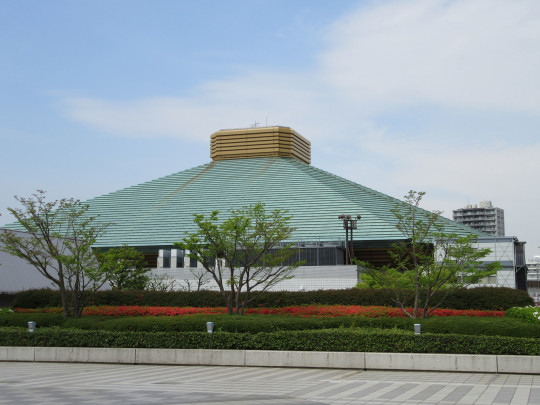
It's sumo season in Tokyo! Though, to be fair, it's sumo season three months per year, as this arena, the Kokugikan in Ryôgoku, on the East bank of the Sumida-gawa two stops from Akihabara on the Chûô-Sôbu line, hosts half of the year's six major tournaments.

It wasn't open when I visited Tokyo, so I didn't see inside, but even then, there are apparently, and unsurprisingly, a lot of sumo-related places to visit in Ryôgoku, like Ekô-in temple... and I missed them all! Well, apart from the odd statue.
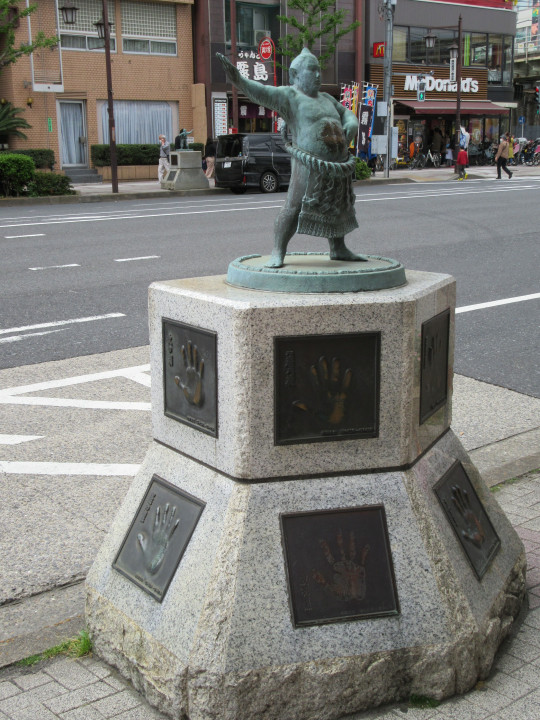
I went to Ryôgoku area without a real plan, I wandered around and found some interesting places I'll get to another time, but one thing I think I planned was to try the "lunch of champions", the classic stew for sumo wrestlers: chankonabe, or chanko for short. It was rich and copious, as you'd expect, and, as I remember, I didn't quite finish it.
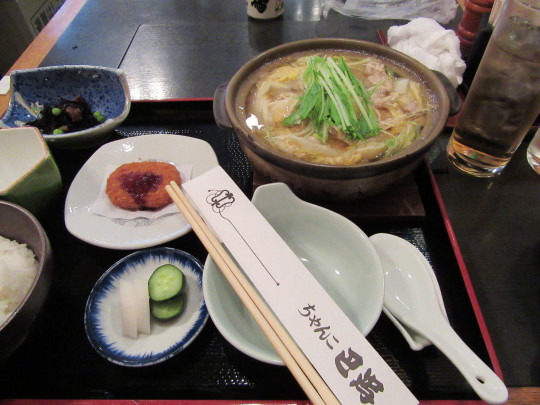
6 notes
·
View notes
Text
Pitchfork is being 'folded into GQ magazine' which is corporate speak for 'you are (almost) all fired'.

@jennpelly
I don't know what will happen to the Pitchfork website or Youtube channel , but now might be a good time to revisit some of the many great interviews they have done over the years.
61 notes
·
View notes
Text



Grzegorz Chanko - editorial “The Sunseeker” ZARA MAN Summer 2024
Photographer: Dudi Hasson
source: thefashionisto.com
4 notes
·
View notes
Text
Will I get deep enough into sumo again that I'll start sumo posting on Tumblr?
We'll see. But my bestie and I are making chanko nabe this Wednesday and I can't wait urrghh.
7 notes
·
View notes
Text
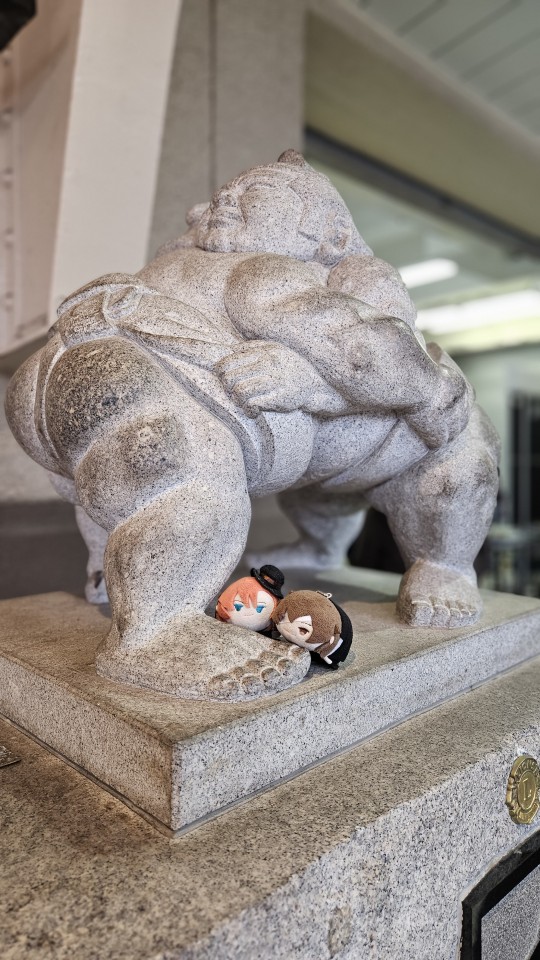
Today is sumo wrestling! We're in the middle of one of the big tournaments that lasts for 15 days!

Starting it off with chanko nabe! This hot pot is what the top sumo wrestlers eat to grow big, and Chuuya's gonna eat the whole thing!
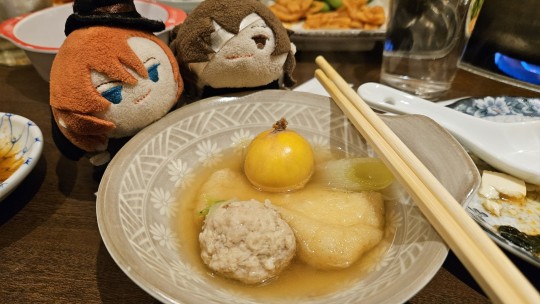
That round ball is a whole cooked yolk. It's supposedly from a pre-laid egg...

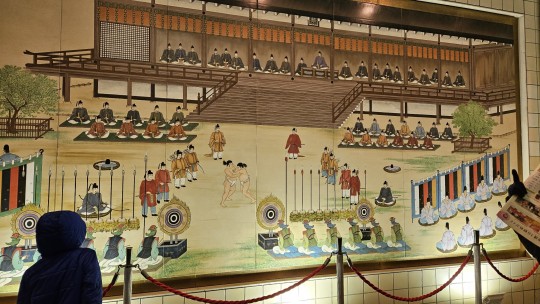
Historic depictions of the sumo wrestlers.

Chuuuyaa, your hat's in the way!

You're such an asshole, Dazai.
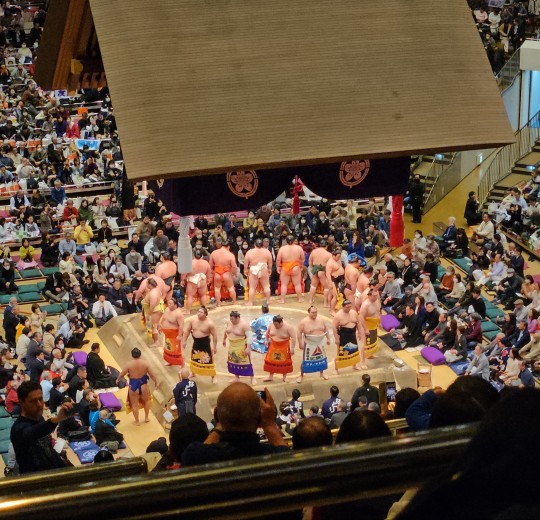
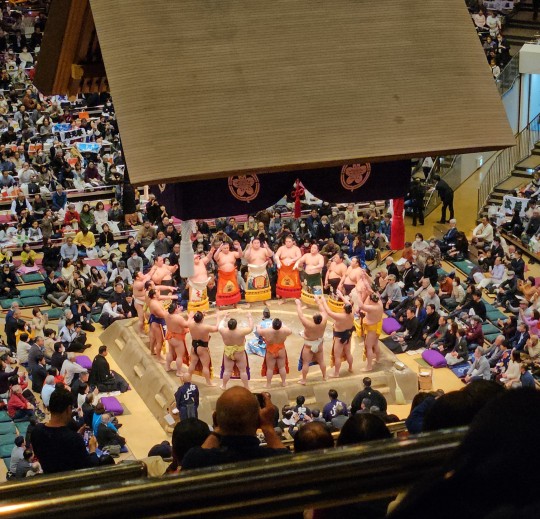
All the senior fighters round up in a circle to introduce themselves.

The champion stamps his feet...
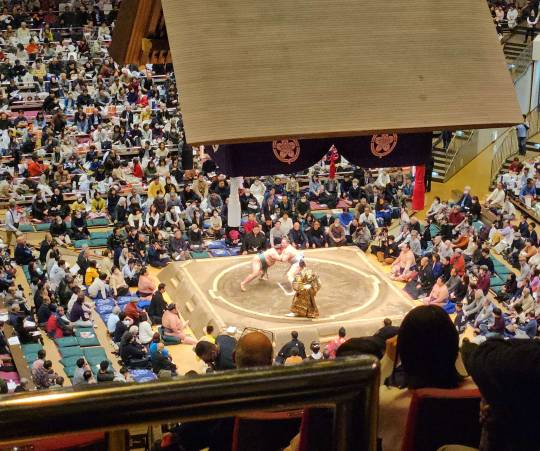
And then they fight!

That face slap!
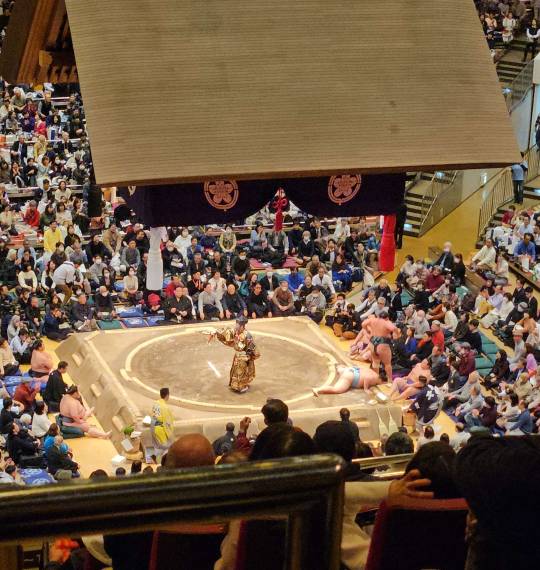
And he's out!!
#bungou stray dogs#dazai osamu#nakahara chuuya#soukoku#my pics#my photos#sumo#chanko nabe is delicious! the broth was flavorful! the chewy egg yolk not so much...
18 notes
·
View notes
Text
i'm not too far into pripara but one thing i appreciate about it is how this character

is never made fun of for her weight. she serves as comic relief but her weight is never the butt of the joke. she's even told that she could be a model. given this is an idol show, i'm actually surprised at how respectfully they treat chanko.
17 notes
·
View notes
Text

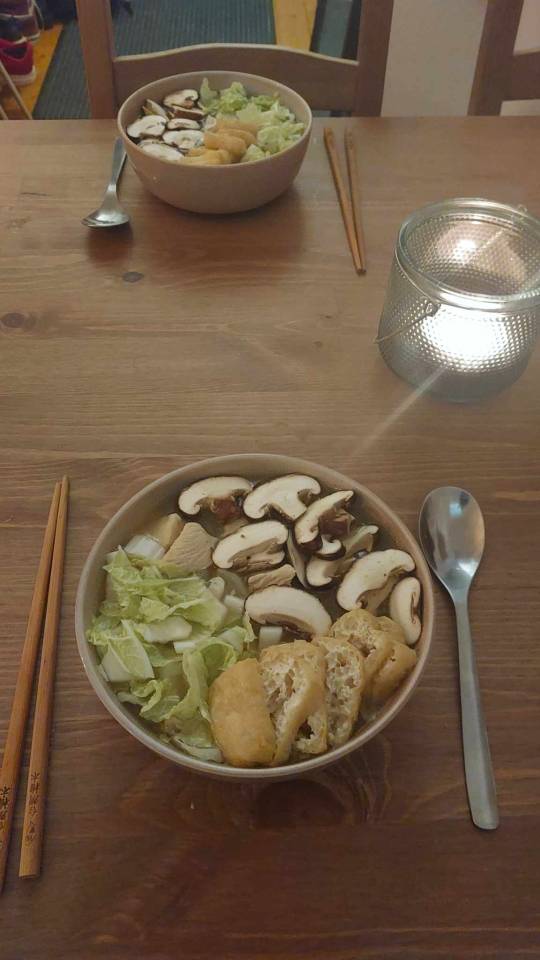
CHANKO NABE (SUMO WRESTLER SOUP, 1937)
In the midst of planning our upcoming trip to Japan, and with the weather changing from summer to fall, I deemed it necessary to try making this next warm and cozy Tasting History dish: Chanko Nabe. This hearty soup, usually served alongside many bowls of rice, was a common meal for sumo wrestlers during training in the early 20th century. During the Edo Period (1603-1868), sumo became less a way for samurai to train for battle and more of a competition between elite athletes. As this change came to pass, sumo wrestlers started to become known for their large size, a result of eating hearty dishes like Chanko Nabe alongside lots of rice. There is technically no one recipe for Chanko Nabe, as it varies from place to place and can heavily depend on what vegetables are in season. Since a chicken is 'agile and stays on two feet', it is seen as good luck by sumo wrestlers. Therefore, during a sumo tournament, Chanko Nabe is usually made with chicken. This recipe comes from the Chanko Kawasaki Restaurant in Tokyo, from a former sumo wrestler who began making this recipe for the restaurant in 1937. However, the dish can otherwise be made with whatever meat and vegetables are on hand, and can really be customized to your tastes. See Max’s video on how to make the dish here or see the ingredients and process at the end of this post, sourced from his website.
My experience making it:
I strayed a little bit from the stated recipe for this one, partially because the original recipe was meant to be customized and tweaked depending on what's available. I found most of the ingredients I needed at my local Asian supermarket. Instead of chicken legs, I used 3 boneless, skinless chicken breasts, and I decided to omit the chicken livers entirely, because I honestly worried that the texture of cooked liver would ruin an otherwise lovely dish. I followed Max's ingredient list pretty well otherwise, but I omitted the pickled daikon. I couldn't find thinly sliced fried tofu, so I decided to use agedashi tofu-style, fried, cubed tofu, but cut in thin slices. I also only used 1 pack of shirataki noodles, as I often struggle with strange-textured food, and Max exclaims several times about the unique, gelatinous texture of the shirataki.
I first brought the chicken broth to a simmer, then added the dashi powder, mirin, and miso paste. I then added the soy sauce and minced garlic, then let the pot alone to simmer for half an hour. While it simmered, I prepped and chopped my other ingredients. Next I added the chicken, then the carrot, onion, and daikon. After simmering for another 15 minutes, I decided to turn off the heat and ladle the Chanko Nabe into bowls. This is when I added some sliced shiitake mushrooms, sliced agedashi tofu cubes, and chopped Chinese cabbage to each bowl to let those ingredients just lightly cook in the piping hot broth. In previous hotpots I have had, I have preferred lighter ingredients like this not being overcooked, so I thought some light heat off the element would be perfect. This also made it easier to arrange the dish into one that was a bit more pleasing to look at when I served it forth!
My experience tasting it:
My husband and I dug in with our favourite chopsticks (which we brought back from our previous trip to Taiwan) - meals are made all the more special when you can tie them to memories! I first tried some of the broth by itself. It was like a warm hug - savoury flavour that was perfectly balanced filled each and every tastebud! Familiar Japanese ingredients were noticeable - the faint taste of ocean from the dashi, the saltiness from the soy sauce, and the deep and complex flavour of the miso - but the most dominant flavour was the chicken broth. In future, I would consider even slightly upping the amount of soy sauce, dashi, and miso in order to make those notes a little stronger. Next, I tried some of the Chinese cabbage. It was a lovely vessel for the broth and it retained a little crunch while still seeming 'cooked' in terms of its flavour (no raw bitterness). I tried the fried tofu next. Its fried coating and bubbly inner texture had taken in so much of the broth that it was like a flavour bomb as I bit into it! Definitely a highlight in the dish. Now, confession time: I have never tried shiitake mushrooms before. Let's just say they absolutely did not disappoint! Normally, I am not a fan of the texture of mushrooms, but these had such a nice little spice to them that I was willing to overlook their texture. I consider that a success! I'll admit however, that the chicken, though tender enough, was pretty underwhelming and did not seem to absorb the flavours too well. Next time I would use shredded chicken perhaps, or omit the meat element entirely. The dish wouldn't miss it.
Last but not least, I tried the part of the dish I was most hesitant about: the shirataki noodles. They slurped up just like ramen noodles, which was a plus. Despite Max mentioning multiple times how gelatinous they were, I didn't have too much of a problem with their texture. I would describe them more as dense than gelatinous. My only qualm with them was that they were a little hard to chew and break with my teeth. Overall, the Chanko Nabe was enjoyed thoroughly by both my husband and I, and I also enjoyed the leftovers at work the next day. I plan on making it again, for sure! Chanko Nabe was fairly quick to make, and the process was not too complex. I fully intend on playing around with some different ingredients to find my favourite combo, but the ingredients Max used are a great base. We were so full after eating this meal, we definitely felt like sumo wrestlers. If you end up making this dish, if you liked it, or if you changed anything from the original recipe, do let me know!
Harder-to-find ingredients:
Check your local Asian supermarket!
Chanko Nabe (Sumo Wrestler Soup) original recipe (1937)
Sourced from Chanko Kawasaki Restaurant in Tokyo from their 1937 recipe.
Pieces of chicken meat and chicken liver are added to an earthenware pot containing chicken stock. The dish also includes carrots, onions, Chinese cabbage, pieces of fried tofu and shirataki…
Modern Recipe
Based on Chanko Kawasaki Restaurant's recipe (1937) and Max Miller’s version in his Tasting History video.
Ingredients:
6 cups (1.5 L) chicken broth
1 tbsp dashi powder
1/4 cup (60 ml) mirin
2 tbsp white miso
1 tbsp soy sauce
1 tsp minced garlic
4 boneless skinless chicken legs, cut into bite-sized pieces
4 chicken livers, cut into bite-sized pieces
1/2 cup chopped carrot
1/2 cup chopped onion
Chinese or napa cabbage
2 packs of shirataki noodles, drained and rinsed
Several slices abura age (fried thinly sliced tofu)
Fresh and pickled daikon radish
Shiitake mushrooms
Method:
In a large pot over medium-high heat, bring the chicken broth to a boil. Stir in the dashi powder and boil for 1 minute.
Lower the heat to medium and add the mirin and miso. Stir for a few minutes until the miso has completely dissolved and the broth is cloudy.
Stir in the soy sauce and garlic, then simmer for 30 minutes.
Bring the broth to a boil. Add the chicken and cook for 5 minutes.
Add the carrot, onions, daikon, and any vegetables that will take longer to cook. Cover and simmer for 10 to 15 minutes.
Add the rest of the ingredients and cook for a few more minutes, (or more, or less, depending on your preference). People will cook it for a long time, a short time, or turn off the heat and let the ingredients just warm up.
For extra authenticity, serve the chanko nabe forth with large quantities of steamed rice.
#max miller#tasting history#tasting history with max miller#cooking#keepers#historical cooking#20th century#Chanko Nabe#Chanko Kawasaki#1930s#Japan#Asia#Ramen#sumo wrestlers#japanese recipes#meat#chicken#tofu#soups
3 notes
·
View notes
Text
Sumo is the best and worst sport there is
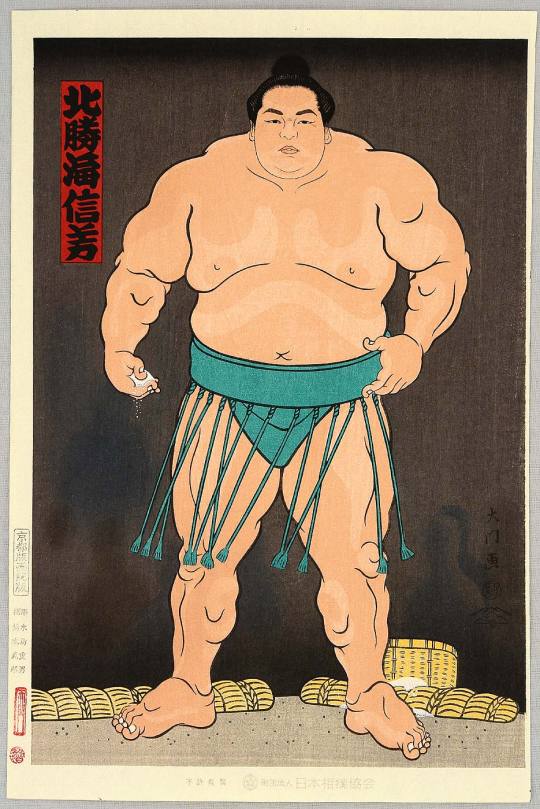
Champion Sumo Wrestler Hokutoumi by Kinoshita Daimon, 1985
I've been playing Street Fighter 6 and maining E. Honda, which is a gateway drug to learning about sumo, which is a gateway drug to watching hours of sumo wrestling on this 24 hour sumo rebroadcast twitch stream.
It's a fun spectator sport but it turns out that sumo is like American football but worse, because in addition to getting their skulls smashed together constantly, they also get all kinds of health problems from the stress, injuries, and diet. The average sumo wrestler lives to be 65 and is likely to get diabetes. It's inhumane. And it's backed by hundreds of years of tradition so they can get away with it.
...but, unfortunately, sumo is cool as shit. Here's why:
You lose a match by being forced out of the ring or getting knocked down. You win by being immovable. How do you become immovable?

By having more mass than your opponent, of course.
Every match starts with both wrestlers rushing together and colliding. All else being equal, the heavier wrestler has an inherent advantage at the start. Strength alone is insufficient; if he doesn't have the mass he'll just bounce off the other guy. If the match isn't decided in the first second, then it becomes a hellish grappling game, as they both try to figure out how to tip over a person who's built like the dog that cannot be tipped over.
So there's this arms race happening behind the scenes as coaches use the power of Dark Nutrition Science to try and make their guys heavier.
Every wrestler is trying to be heavier than average, so the average weight keeps going up. It's been going up since the 60s. Building and sustaining mass, along with doing the accompanying strength training to stay agile, is the challenge that defines a sumo wrestler's career.
This is the real game. The teams (which are called 'stables,' to give you a sense of why there might be a problem here) are competing with each other to win the title of Who Can Put The Most Calories In A Guy.
It's nightmarish, but if I'm being honest, it's also compelling. Like, this is what all pro sports do: relentlessly instrumentalize human beings into honed single-purpose machines. But in sumo the qualities being optimized for are moving fast, hitting hard, and being huge. And it turns out that a person can get really good at all three of those! It's impressive! Inspiring, even! It's just too bad that, you know, it eventually kills them.
Pro sumo is a dangerous, exploitative sport. It probably shouldn't exist. But as long as it does, do yourself a favor: Check out that stream, pull up the wikipedia page on sumo to read along so you can figure out what they're doing, and bear witness to a spectacular and deranged application of human ingenuity and drive.
It does help if you know hiragana so you can read their names. But, cmon, it's 2023. Learn hiragana already. It takes like a couple days on duolingo. The stream chat also has a bot that gives a short bio of any wrestler if you type ![their name]. If channel host sahairah happens to be there, and they often are in the evenings, they will patiently answer questions you have. but don't show up there and ask a ton of dumbass questions, because that would then be my fault.
12 notes
·
View notes
Text





Trying on the outfits added to the silver dollar store. Man I really gotta grind for cash.

Cosmo and Ajimi are being added to Idolland! Now we can pretend to be Chanko because we're sure as hell not getting her as an NPC. Wonder if any of their songs will show up in April.
#michie gacha diaries#michie idol land pripara diaries#idol land pripara#look at me#im the chanko now#if you cant give us chanko#at least give us just my chance call#gosh priparis had some of the best songs#most of the new movie songs tbh
3 notes
·
View notes
Text
Made chanko nabe tonight and discovered there is basically no upper limit on the amount of cabbage you can add. You filled your pot up and think thats enough? You fool, you fucking imbecile.

7 notes
·
View notes
Text
PriPara - Round 2 Match 15

#bracket#tournament#brackets#tournaments#character bracket#character tournament#fandom bracket#fandom tournament#tumblr bracket#tumblr tournament#poll bracket#poll tournament#poll#Pretty Series Bracket#pripara#idol land pripara#idol time pripara#reona west#Chanko Nabeshima#round 2
10 notes
·
View notes
Text

Vegan Chanko Nabe (The Breakfast of Sumo Champions)
#vegan#breakfast#lunch#dinner#hotpot#japanese cuisine#asian cuisine#chanko nabe#stews#mushrooms#cabbage#bok choy#dashi#ginger#garlic#sesame seeds#soy sauce#mirin#sesame oil#onion#seitan#vegan chicken#vegan pork#veganized#vegan egg#tofu#rice flour#mustard#turmeric#black salt
9 notes
·
View notes
Text
damn i want to go to a sumo basho so bad. ive never been attached to the idea of visiting japan like some people are, i could take it or leave it, but ive gotten so into sumo in the past few months and now i want to go mainly to do that. check out midnightsumo on twitch btw if you are interested in seeing the sport.
5 notes
·
View notes
Text

Grzegorz Chanko - Ziggy Chen Fall 2025 Menswear, Paris
source: fashionsnap.com
2 notes
·
View notes
Text


1 note
·
View note
Text
Voicepeak Minase Kou & Rito and Oedo Chanko and AI Voice 2 Tsunose Kotone Release!
Minase Kou, Rito, and Oedo Chanko have all finally released for Voicepeak this week and are officially available on multiple retail sites in Japan! そして本日はついに���『VOICEPEAK 大江戸ちゃんこ』『VOICEPEAK 水奈瀬コウ』『VOICEPEAK 水奈瀬リト』の発売日です✨https://t.co/yqANv0Dpyn#ボイスピ #大江戸ちゃんこ #水奈瀬コウ #水奈瀬リト pic.twitter.com/zSJBs7vW4y— AHS公式@ボイスピ大好評発売中! (@ahsoft) August 22, 2024 All three banks are 10,800 yen (including tax)…
#AI Talk#AI VOICE#AI VOICE 2#AITalk6#Minase Kou#Minase Rito#Oedo Chanko#SSS LTD#Tohoku Project#Tsunose Kotone#VoicePeak
1 note
·
View note